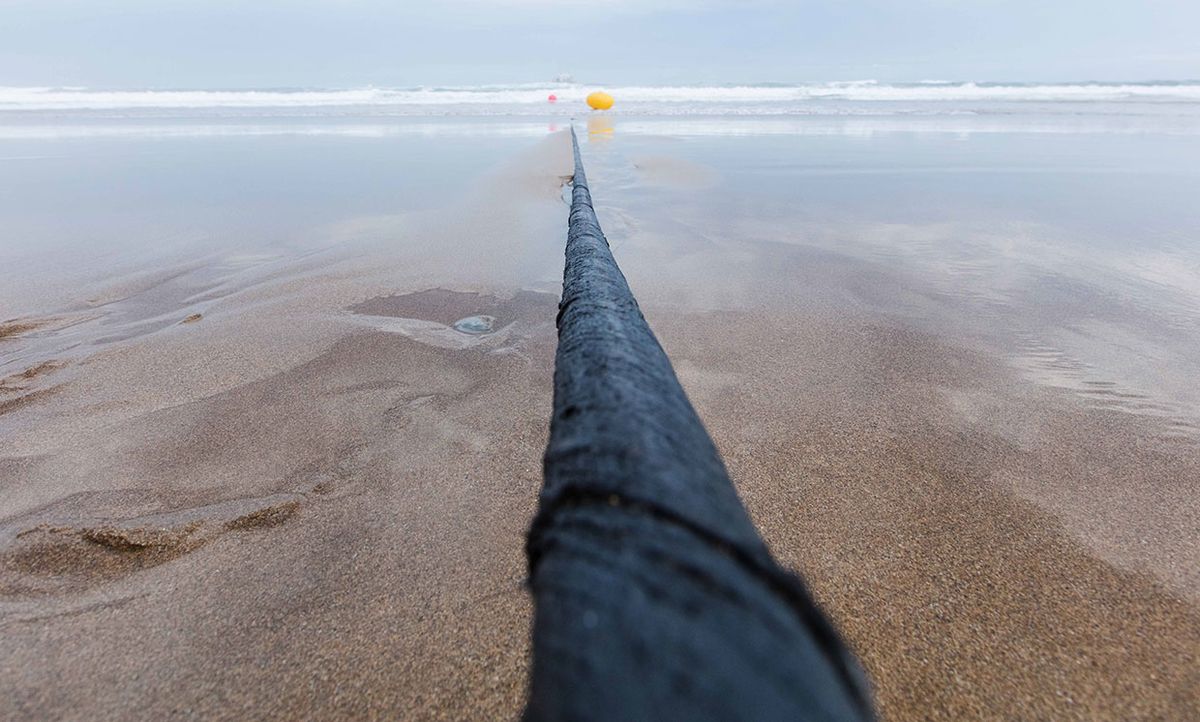Fiber-optic engineers have set a new record for data-transmission efficiency in an experiment on a submarine cable with the highest data capacity of any yet in operation. Able to carry up to 20 terabits per second on each of eight fiber pairs, the MAREA cable runs 6605 kilometers between Virginia Beach, Virginia, and Bilboa, Spain. At the Optical Fiber Communications Conference cosponsored by IEEE—which ran from 3–7 March in San Diego—engineers from Infinera and Facebook reported that new transmitting and receiving equipment could squeeze 26.2 terabits per second through the same bandwidth on MAREA.

That isn't a huge increase, but it’s important because it set a record for the most bits per second squeezed through a limited fiber bandwidth. This was accomplished with a modulation scheme never before demonstrated on a transatlantic cable, says Geoff Bennett, director of solutions and technology for Infinera. Called 16QAM, for quadrature amplitude modulation, it digitally modulates a four-bit code so it can have one of 16 values at every interval, as shown in the figure. That allowed the engineers to transmit a record 6.21 bits per second per hertz of bandwidth. This high-data-rate transmission, using commercial equipment from Infinera, pushed the cable close to the Shannon noise limit.
Presenters at the conference noted that transoceanic cables now carry more traffic from data centers than from other users. The event showcased a major focus on the need for increased bandwidth for data center cables in order to handle this traffic source. But most undersea cables yield more capacity not by improving bandwidth efficiency, but by adding more transmission bands. That is exactly the case with the 12,800-km Pacific Light Cable stretching between Hong Kong and Los Angeles that will eclipse MAREA for highest capacity per fiber next year. Subcom, the Pacific Light Cable’s designer, says that doubling that cable's bandwidth by adding a second transmission band will make it capable of shuttling 24 terabits per second on each of six fiber pairs.
But Infinera’s approach, increasing bandwidth efficiency, may be the route of choice for boosting the transmission capacity of future undersea cables because they span longer distances, are more expensive to build, and have fiber counts limited by the need to run wires through the cable to power repeaters.

To transmit 16QAM through MAREA, a team led by Stephen Grubb of Facebook and Pierre Mertz of Infinera ganged the signals from six laser transmitters together into a 212.5-GHz band superchannel transmitting 618.75 gigabits per second, including error correction coding. Each laser wavelength included four subcarriers. They set up the test on fibers that were not in use, interspersing amplified spontaneous emission noise on wavelengths that were not carrying data to simulate the effects of signals at those wavelengths. Then they stepped through wavelength channels to verify error-free operation. That yielded the efficiency record of 6.21 bits per second per hertz.
Mertz considered the biggest challenge to be operating close to the Shannon limit. At that point, he said, “Every gain we make becomes harder and harder.” To further test the hardware, they transmitted 8QAM across the Atlantic and back again. Sending the signals across on the 13,210 km round trip at the longer wavelength reduced the per-fiber capacity to 18.6 gigabits per second, and reduced efficiency to 4.46 bits per second per Hertz.
Infinera’s Bennett credits the group’s success to two factors. One is Infinera's use of integrated photonic circuits, with all six lasers on the same substrate, rather than on separate chips. That makes it easier to lock laser wavelengths together to enhance performance. Doing so can be difficult in setups where the temperature of each separate chip drifts independently. The other factor is Nyquist shaping the subcarrier bands to reduce the bandwidth needed to extract the clock for signal timing.
This is an important research area because big data companies remain hungry for bandwidth. Facebook expects strong growth in augmented reality, virtual reality, and artificial intelligence. New technology will be needed to sustain that growth, said Facebook’s Herve Fevrier and five colleagues who presented a paper at the conference. That means more cable capacity, greater cable flexibility, and lower cost per bit.
To circumvent Shannon's limit, Facebook wants to increase the fiber count in cables. That will require redesigning cables so they can provide more electrical power for repeaters situated along their routes, and so the cables can fit more than 16 to 25 fiber pairs. Further out, they foresee the need for more cores to further expand transmission capacity.
Jeff Hecht writes about lasers, optics, fiber optics, electronics, and communications. Trained in engineering and a life senior member of IEEE, he enjoys figuring out how laser, optical, and electronic systems work and explaining their applications and challenges. At the moment, he’s exploring the challenges of integrating lidars, cameras, and other sensing systems with artificial intelligence in self-driving cars. He has chronicled the histories of laser weapons and fiber-optic communications and written tutorial books on lasers and fiber optics.



